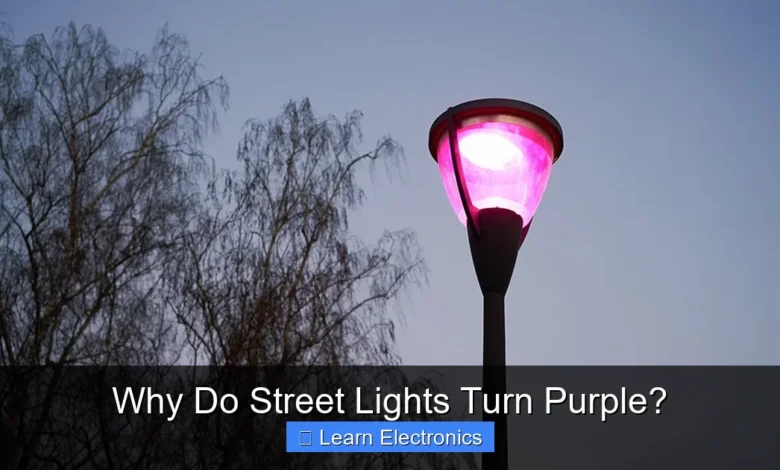Why Do Street Lights Turn Purple?

Why Do Street Lights Turn Purple? This phenomenon is primarily due to a manufacturing defect in certain batches of LED street lights, where the crucial phosphor coating responsible for converting blue light into white light degrades or delaminates prematurely.
This widespread issue affects specific LED fixtures, causing them to emit a distinct purple or bluish-purple hue instead of the intended white light, impacting both visual clarity and the aesthetic uniformity of urban illumination. Understanding this process requires delving into the specific electronics of these lighting systems.
Quick Answers to Common Questions
So, why do street lights turn purple in the first place?
Great question! This striking purple color happens when the protective coating on some LED street lights begins to degrade, revealing the blue light spectrum underneath, making them appear purple instead of white.
Is a purple street light broken, or should I be concerned?
While it’s certainly an unexpected color, a purple street light is still functional and generally safe. The color change indicates a defect in the LED’s phosphor coating, but it doesn’t usually impact its ability to illuminate the area.
Does this mean all LED street lights will eventually turn purple?
Thankfully, no! This specific purple phenomenon is primarily linked to a particular batch or manufacturer of LED lights. Newer and different models are unlikely to develop this unique purple glow, so don’t expect a widespread lavender landscape.
📑 Table of Contents
The Science Behind White LED Street Lights
To comprehend why some street lights turn purple, it’s essential to first understand how modern white light-emitting diodes (LEDs) produce their illumination. Unlike incandescent bulbs that generate light through heat, LEDs create light through electroluminescence, a more efficient process involving semiconductor materials.
How White Light is Created in LEDs
The vast majority of white LEDs used today, particularly in street lighting applications, do not inherently emit white light. Instead, they rely on a clever trick involving two primary components:
- Blue LED Chip: The core of the white LED is typically a blue light-emitting diode. These chips are highly efficient at converting electrical energy into blue light.
- Phosphor Coating: A critical layer of phosphorescent material is applied over the blue LED chip. When the intense blue light from the chip strikes this phosphor layer, the phosphor absorbs the blue photons and re-emits them at longer wavelengths, typically in the yellow spectrum.
The combination of the original blue light that passes through the phosphor and the newly generated yellow light from the phosphor creates a perceived “white” light to the human eye. The precise color temperature and quality of the white light (e.g., warm white, cool white) are determined by the specific chemical composition and thickness of this phosphor coating.
The Root Cause: Phosphor Degradation Leading to Purple Street Lights
The transition of street lights to a purple hue is almost exclusively attributed to a defect in the phosphor coating used in particular LED luminaires. This isn’t a universal problem with all LEDs but rather a specific issue that emerged with certain manufacturers or production runs.
Understanding the Manufacturing Anomaly Affecting Street Lights Turning Purple
The problem arises when the phosphor coating fails to maintain its integrity over time. In the affected fixtures, the phosphor layer either degrades chemically or physically delaminates from the blue LED chip. When this happens, the protective and light-converting function of the phosphor is compromised, allowing more of the underlying blue light to escape without being fully converted to yellow. The result is a combination of the remaining partial yellow conversion and the dominant blue light, which our eyes perceive as purple or a deep violet-blue.
Investigations into this issue have pointed to several potential factors:
- Improper Adhesion: The phosphor may not have been properly bonded to the LED chip substrate, leading to premature peeling or cracking.
- Chemical Instability: Certain phosphor formulations might have been less stable under prolonged operation, especially when exposed to heat or UV radiation, leading to a breakdown of their light-converting compounds.
- Quality Control Issues: A lapse in manufacturing quality control during the application or curing of the phosphor layer could result in a thinner, uneven, or structurally weak coating that fails sooner than expected.
Environmental and Operational Factors
While the primary cause is a manufacturing defect, certain environmental and operational factors can accelerate the degradation of the phosphor coating once the weakness is present:
- Heat Exposure: LEDs, though efficient, still generate some heat. If the fixture’s thermal management system is inadequate or if the ambient temperatures are consistently high, this can hasten the chemical breakdown of the phosphor.
- UV Exposure: Though less significant for the internal phosphor, external UV exposure on the fixture’s lens can contribute to overall material degradation, potentially impacting internal components over very long periods.
- Operating Hours: Luminaires that are on for extended periods, such as street lights, naturally experience more wear and tear. A defect that might take years to manifest in a residential setting could become apparent much quicker in continuous street lighting operations.
Impact on Visibility and Safety
The shift from white to purple light in street lighting is more than just an aesthetic concern; it has practical implications for visibility and public safety. The human eye is optimized to perceive a broad spectrum of colors under white light, and a monochromatic or off-spectrum light source can diminish visual performance.
Visual Acuity Under Purple Illumination
White light sources, particularly those with a balanced spectrum, allow the human eye to distinguish colors and perceive details accurately. When a street light emits purple light:
- Reduced Contrast: The purple hue can significantly reduce contrast, making it harder to discern objects, road markings, and variations in the road surface. This is particularly problematic for objects that reflect different colors of light under normal conditions.
- Color Perception Alteration: Emergency vehicle lights, traffic signals, and other colored indicators may appear distorted or less vibrant, potentially leading to confusion.
- Increased Glare: In some cases, the more intense blue component of the purple light can contribute to a sensation of increased glare, especially for drivers whose eyes are adapted to night vision.
Safety Concerns for Drivers and Pedestrians
The primary concern with purple street lights is their potential impact on public safety:
- Driving Safety: Drivers may struggle to accurately judge distances, spot hazards, or react quickly to unexpected situations due to impaired visibility. Pedestrians and cyclists may also be less visible under such lighting.
- Security: In areas illuminated by purple lights, the effectiveness of surveillance cameras can be reduced, as color distortion makes identification difficult. The unsettling color can also impact people’s perception of safety in public spaces.
- Psychological Impact: While subjective, some individuals find the purple light disorienting or even eerie, potentially affecting their comfort and sense of security when navigating affected areas at night.
Identification and Remediation Efforts
When street lights start to turn purple, local authorities and utility companies typically initiate a process of identification and replacement. This is a significant undertaking, given the vast number of street lights in any municipality.
Identifying Defective Fixtures
The identification process relies on several methods:
- Public Reporting: Citizens are often the first to notice the change. Many cities and utility companies have online portals, phone lines, or mobile apps where residents can report specific street lights that have turned purple.
- Maintenance Crews: Regular patrols by utility maintenance teams will also identify affected fixtures during their routine checks.
- Automated Systems: With the rise of smart city infrastructure, some advanced street lighting systems can monitor the operational status and even light output quality of individual fixtures, potentially flagging anomalies like color shifts.
The Replacement Process and Future-Proofing
Once identified, the remediation typically involves:
- Warranty Claims: Since this is a manufacturing defect, utility companies often work with the original luminaire manufacturers to claim warranties and secure replacement fixtures, minimizing the financial burden.
- Phased Replacement Programs: Depending on the number of affected lights, replacements might occur in phases, prioritizing high-traffic areas or areas with significant safety concerns.
- Improved Specifications: Moving forward, municipalities and utilities are adopting more stringent specifications for new LED street light procurements. This includes demanding higher quality phosphor coatings, extended warranty periods, and rigorous testing protocols to prevent a recurrence of this issue.
- Diversification of Suppliers: To mitigate risks, some entities are also diversifying their LED street light suppliers, rather than relying on a single manufacturer or batch that might carry a widespread defect.
Comparison of Light Characteristics: White vs. Purple Street Lights
| Characteristic | Standard White LED Street Light | Purple-Tinted LED Street Light (Defective) |
|---|---|---|
| Dominant Color Output | Balanced white light (blue + yellow/red phosphor) | Strong blue/violet with minimal yellow conversion |
| Color Temperature (CCT) | Typically 3000K – 5000K (Warm to Cool White) | Much higher CCT, often perceived >6000K (Very Cool/Purple) |
| Color Rendering Index (CRI) | Good (CRI > 70 for general lighting) | Poor, significantly reduced ability to render true colors |
| Visibility & Contrast | High clarity, good contrast for objects and road markings | Reduced clarity, poor contrast, difficulty in discerning details |
| Glare Perception | Generally low to moderate | Potentially higher, especially the blue component |
| Energy Efficiency | High efficiency, low power consumption | Remains highly efficient (light output is still energy converted) |
| Intended Lifespan | 50,000 to 100,000+ hours (light output maintenance) | Color shift significantly reduces effective lifespan for intended purpose |
The Future of Street Lighting Technology
The occurrence of purple street lights serves as a learning experience, driving innovation and improvements in LED technology. Manufacturers and municipalities are continuously seeking more robust, reliable, and intelligent lighting solutions.
Innovations in Phosphor Coatings
Future advancements in LED technology will likely focus on:
- Enhanced Durability: Developing more stable and resilient phosphor materials that are less susceptible to degradation from heat, UV, and operational stresses. New encapsulants and bonding techniques will also improve the physical integrity of the coating.
- Ceramic Phosphors: Research into ceramic-based phosphors offers promise for higher thermal stability and longer lifespans compared to traditional organic binders.
- Tunable White Light: More sophisticated LED systems can dynamically adjust their color temperature, offering flexibility and even adapting to different times of night or seasonal needs. This also provides an inherent redundancy, as slight shifts in one phosphor can be compensated by adjusting others.
Smart Lighting Systems and Their Benefits
Beyond the LED chip itself, the integration of smart technology is transforming street lighting:
- Adaptive Lighting: Smart systems can dim or brighten lights based on real-time conditions, such as traffic density, pedestrian presence, or ambient light levels, saving energy and extending fixture life.
- Remote Monitoring and Diagnostics: These systems can continuously monitor the performance of each luminaire, immediately flagging issues like outages, dimming, or color shifts. This allows for proactive maintenance, reducing response times and improving operational efficiency.
- IoT Integration: Street light poles are becoming hubs for various IoT sensors, collecting data on air quality, noise levels, and even acting as Wi-Fi hotspots, transforming city infrastructure.
In conclusion, the issue of street lights turning purple, while visually striking, is a direct result of specific manufacturing defects in the phosphor coatings of certain LED luminaires. This technical glitch compromises the intended white light output, leading to reduced visibility and potential safety concerns. However, this challenge has spurred the industry to enhance quality control, refine material science, and accelerate the adoption of smarter, more resilient lighting technologies. As municipalities replace affected fixtures and incorporate newer, more robust designs, we can look forward to a future where our urban landscapes are reliably and safely illuminated with high-quality, long-lasting white light, free from unexpected color shifts. The experience underscores the ongoing evolution in lighting electronics and the importance of continuous innovation to ensure reliable public infrastructure.
Frequently Asked Questions
What causes street lights to turn purple?
This phenomenon, where street lights turn purple, is primarily due to a manufacturing defect in the LED phosphor coating. The coating, designed to convert blue light from the LED into white light, can degrade prematurely, causing the underlying blue light to become visible, which appears purple to the human eye.
Is there a safety concern when street lights turn purple?
While the purple hue may be aesthetically unusual, there are generally no immediate safety concerns for the public. The defect primarily affects the color output rather than the electrical safety or structural integrity of the fixture itself, though visibility might be slightly reduced compared to a fully functional white light.
Is this a widespread issue?
Yes, this issue has been reported in various locations across North America and other parts of the world, affecting specific batches of LED streetlights from certain manufacturers. Utility companies are aware of the problem and are typically working to replace the affected fixtures as they are identified.
What should I do if I see purple street lights in my area?
If you notice street lights turn purple in your neighborhood, you should report it to your local utility company or municipal public works department. They are usually responsible for maintaining street lighting and will likely have a system in place to track and schedule replacements for defective units.



